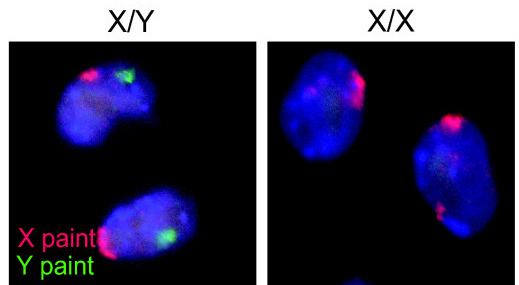 | ||
The ZW sex-determination system is a chromosomal system that determines the sex of offspring in birds, some fish and crustaceans such as the giant river prawn, some insects (including butterflies and moths), and some reptiles, including Komodo dragons. The letters Z and W are used to distinguish this system from the XY sex-determination system.
Contents
In contrast to the XY sex-determination system and the X0 sex-determination system, where the sperm determines the sex, in the ZW system, the ovum determines the sex of the offspring. Males are the homogametic sex (ZZ), while females are the heterogametic sex (ZW). The Z chromosome is larger and has more genes, like the X chromosome in the XY system.
Significance of the ZW and XY systems
No genes are shared between the avian ZW and mammalian XY chromosomes, and, from a comparison between chicken and human, the Z chromosome appeared similar to the autosomal chromosome 9 in humans, rather than X or Y, leading researchers to believe that the ZW and XY sex determination systems do not share an origin, but that the sex chromosomes are derived from autosomal chromosomes of the common ancestor. These autosomes are thought to have evolved sex-determining loci that eventually developed into the respective sex chromosomes once the recombination between the chromosomes (X and Y or Z and W) was suppressed.
A paper from 2004 compared the chicken Z chromosome with platypus X chromosomes and suggested that the two systems are related. The platypus has a ten-chromosome–based system, where the chromosomes form a multivalent chain in male meiosis, segregating into XXXXX-sperm and YYYYY-sperm, with XY-equivalent chromosomes at one end of this chain and the ZW-equivalent chromosomes at the other end.
In birds
While there has not been extensive research on other organisms with the ZW sex-determination system, in 2007, researchers announced that chicken and zebra finch's sex chromosomes do not exhibit any type of chromosome-wide dosage compensation, and instead seem to dosage compensate on a gene-by-gene basis. Specific locations on the chicken Z chromosome, such as the MHM region, are thought to exhibit regional dosage compensation, though researchers have argued that this region does not actually constitute local dosage compensation. Further research expanded the list of birds that do not exhibit any type of chromosome-wide dosage compensation to crows and ratites, thus implying that all avian chromosomes lack chromosome-wide dosage compensation. Both transcriptional and translational gene-specific dosage compensation have been observed in avian sex chromosomes.
It is unknown whether it might be that the presence of the W chromosome induces female features, or whether instead it is the duplication of the Z chromosome that induces male ones; unlike mammals, no birds with a double W chromosome (ZWW) or a single Z (Z0) have been discovered. However, it is known that the removal or damage to the ovaries of female birds can lead to the development of male plumage, suggesting that female hormones repress the expression of male characteristics in birds. It appears possible that either condition could cause embryonic death, or that both chromosomes could be responsible for sex selection. One possible gene that could determine sex in birds is the DMRT1 gene. Studies have shown that two copies of the gene are necessary for male sex determination.
In snakes
On November 3, 2010, scientists announced the discovery of a female Boa constrictor that can produce offspring without mating and, through such asexual reproduction, produced 22 female offspring, all with a WW chromosome genetic makeup. Although this result has been achieved in laboratory settings previously, never before has it been witnessed under natural circumstances. It is not clear as to whether the all-female snake neonates will eventually mate with a male, or reproduce asexually, or do both as does their mother. However, because of their WW chromosomes, any offspring they produce will be female.
In moths and butterflies
In Lepidoptera (moths and butterflies), examples of Z0, ZZW, and ZZWW females can be found. This suggests that the W chromosome is essential in female determination in some species (ZZW), but not in others (Z0). In Bombyx mori (the commercial silkworm), the W chromosome carries the female-determining genes.
